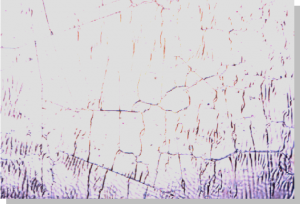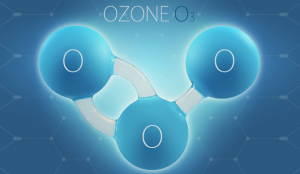Identifying the Problem
If you have spent any amount of time manufacturing or using photopolymer plates, you most likely have run into an issue with plate cracking at one point or another. It is often the assumption that plate cracking stems from exposure to UV light by not being properly stored or protected through the primary converting process. Often this assumption would be correct, but cracking can also stem from exposure of the plates to ozone. Both UV light and ozone are almost always present. But if plate cracking is an issue, how does one identify the root cause?
The quick answer is that damage stemming from UV light is common to have a spider web effect. Cracks can run in any direction and angle. Cracking is often in both the plate surface and the plate floor, and as it worsens the cracks become more prevalent and much deeper. Whereas cracking stemming from ozone damage generally starts with many short fine cracks that run parallel across the plate cylinder, or at 90 degrees of the direction that the plate wraps around the print cylinder or sleeve. With prolonged exposure to ozone, these fine cracks can also become deeper and overlap one another.
UV & Ozone Damage in Platemaking

It is in platemaking that the UV light-sensitive material becomes vulnerable. Exposure to light sources rich in UV will cause a loss of physical properties to the polymer. UV light blocking film, shields, or tubes should be used on lighting inside the plate room, including over the fluorescent lamps inside the light table. While UV light is the source of polymerization of the material, it can also unwantedly pre-expose raw material or damage finished plates. The platemaker determines the minimum time required to post expose (UV-A) and detack, or light-finish (UV-C).
Post-exposure ensures that all material on the plate is completely exposed, while the exposure to UV-C is to make sure that the tackiness is removed from the plate. Both processes affect the durometer (hardness) of the plate along with the surface tension of the plate face. Hardness and surface tension both affect the ink releasing characteristics of the plate. When the plate is out of spec, then the press operator is left to try to compensate through non-standard ink and impression settings. Overexposure to either UV-A or UV-C in the platemaking process may not immediately show signs of cracking but can yield a plate that will not last as long as it is capable of lasting. Plates that are underexposed are much more susceptible to ozone attack while using excessive light finishing (UV-C), plates will decrease ozone resistance.
When leaving your plate making operation for the day be mindful of any plates that are left in the post expose/detack drawer. We understand that the lamps will turn off at there set times, but if the main unit remains running, you must consider that any electrical motors can produce ozone and ultimately reduce plate life. These motors are typically cooling fan or exhaust motors. Ideally is a far better idea to just wait out the plates and remove them before turning off the plate making equipment. If you have a combination plate unit that requires the washout solution or water to remain heated and therefore you want to leave the equipment powered on, then remove the finished plates before leaving for the day or weekend.
UV & Ozone Damage at Press
Damage stemming from light or zone attack is most likely once the plate is under stress and surface tension is increased. This begins with the mounted plate, and increased as the impression and ink settings take place on the press. While it is not always feasible to block all UV light in a pressroom, one area that can be addressed is between-color lighting that comes in very close contact with the photopolymer plates. Setting final ink and impression settings at press speed will help in achieving the kiss impression needed to maximize plate life.
It is in the pressroom that ozone is often most apparent. Ozone (O3) is a highly reactive gas compound composed of three atoms of oxygen. Ozone occurs both in the Earth's upper atmosphere and at ground level. In areas such as a pressroom, the most likely generators of ozone are electrical motors and corona treaters. If you experience plate cracking attributed to ozone, you can contact your platemaker or photopolymer supplier and request an assessment of the area in question. Ozone measuring devices measure ozone in parts per million/billion. Normally deterioration of photopolymer occurs at an ozone level of around 50 ppm.
Ozone is always present in the atmosphere, and naturally occurring ozone is generated by electrical discharge like lightning or sunlight. Ozone becomes more prevalent in the summer months. Equipment like printing presses, electric motors, and corona treaters generate ozone levels many times higher than what is typically found in nature unless you are in the middle of a lightning storm. As the temperature increases in the pressroom or during the summer months, the more severe the ozone effect will be.
UV & Ozone Damage in Storage

Plate storage systems vary from convertor to convertor, but these areas should protect plates from white light, UV light, fluorescent light, and sunlight. Even if plates are being stored in drawers, they should be wrapped in sealed black poly bags to minimize the effect of ozone and light damage. Regardless of the system used, minimal contact minimizes damage. A suitable temperature for storage is required, and there must be protection from UV-light and ozone. The ideal plate storage area ranges from photopolymer manufacturer to manufacturer. Some recommend a cool, dark, and dry environment, i.e. 59 - 68°F at 55 percent relative humidity (+/- 5 percent). Others find that temperatures ranging from 40 - 100°F are acceptable with little or no humidity control as the presence of H2O has little effect on the photochemical process. UV light filters should be used over all lights and windows.
Pay close attention to any make up air entering the storage area. There have been some cases that air supply to a mezzanine or plate storage area just happened to be picking up on the exhaust from a press or laminator utilizing a corona treater.
If you want to learn more about this subject, please feel free to reach out to us by calling 1-800-445-4017, or by e-mail at [email protected]. All Printing Resources has formed our Technical Solutions Group (TSG) to encompass our full range of expertise in all critical areas of the flexo process. This team is made up of industry professionals dedicated to being up-to-date on new technologies along with best practices. They are armed with the latest in diagnostic tools and are experienced in problem-solving that can achieve sustainable results. The TSG has walked in your shoes, and have felt your pain.
